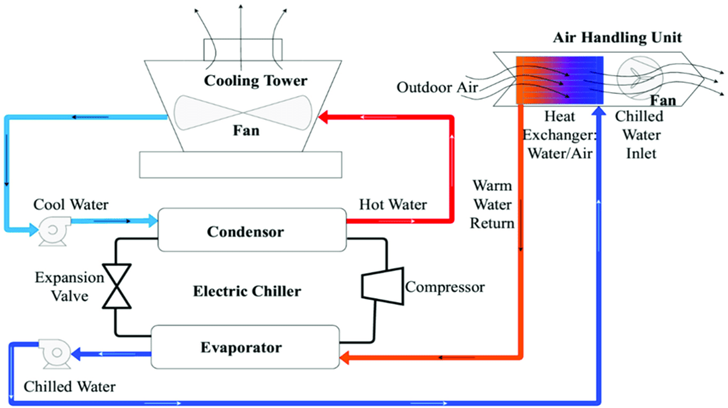When designing or renovating a building, understanding the layout of the HVAC system is crucial. The HVAC (Heating, Ventilation, and Air Conditioning) system plays a significant role in ensuring comfort, air quality, and energy efficiency within a building. Whether you’re a contractor, architect, or a homeowner, knowing the type of plan that displays the layout of the HVAC system is essential for proper installation and maintenance. In this article, we will explore the different types of plans used to show HVAC layouts, their importance, and why you need to understand them for optimal system performance.

What is an HVAC Layout Plan?
An HVAC layout plan is a detailed diagram that shows the positioning of HVAC equipment and ductwork throughout a building. These plans are typically drawn up by engineers or HVAC designers and illustrate where air ducts, pipes, vents, thermostats, and other components are located within a structure. HVAC plans are a critical part of the construction and renovation process, as they ensure the system will function efficiently, meet building codes, and provide the desired level of comfort.
Types of HVAC Plans: Which One Shows the Layout?
There are several types of HVAC plans that provide detailed information about different aspects of the system’s design. The most common types of HVAC plans include:
1. HVAC Floor Plan
The HVAC floor plan is the most common type of plan used to show the layout of an HVAC system. This plan typically provides a top-down view of each floor in a building, showing the precise location of all HVAC components, including:
Air ducts: The pathways that carry air throughout the building.
Vents and registers: The openings that allow conditioned air to enter rooms.
Thermostats: Devices used to control the temperature of the building.
Air handling units: Equipment that regulates airflow and temperature.
Pipes and conduits: For water or refrigerant distribution in hydronic or air conditioning systems.
An HVAC floor plan ensures that every component of the system is strategically placed to provide balanced airflow, minimize energy consumption, and comply with building codes.
2. HVAC Riser Diagram
While the HVAC riser diagram doesn’t show the full layout of the HVAC system in the same way the floor plan does, it is crucial for understanding how different HVAC components connect vertically between floors. This diagram typically shows the vertical distribution of ducts, pipes, and wiring that run through the building. It helps engineers, contractors, and installers visualize the path HVAC components take through different levels of the structure.
For multi-story buildings, the HVAC riser diagram is essential for ensuring that systems like chilled water pipes, ductwork, and refrigerant lines are correctly aligned and sized for efficient operation. It ensures that the air handling units on different floors are connected and can maintain a consistent temperature across the entire building.
3. HVAC Piping and Ductwork Layout Plan
The HVAC piping and ductwork layout plan is a specialized diagram that focuses on the layout of the system’s pipes and ducts. This plan is often used in combination with the floor plan and riser diagram. It offers more detailed views of:
Duct sizes: Proper duct sizing is crucial for ensuring that air is distributed efficiently.
Pipe routes: Shows the location of pipes used for heating, cooling, and refrigeration systems.
Airflow direction: Indicates how air will move through the ducts and pipes.
This plan is especially important for ensuring the correct installation of ductwork, which can directly impact the system’s energy efficiency and airflow effectiveness.
4. HVAC Equipment Layout Plan
In addition to the layout of ducts and pipes, an HVAC equipment layout plan provides details on the location and specifications of HVAC equipment within the building. This includes units such as:
Furnaces
Air conditioners
Heat pumps
Boilers
Ventilation fans
This type of plan helps contractors and installers understand where each piece of equipment should be placed for optimal performance. It also ensures that each unit is accessible for maintenance and that it fits within the available space.
Why Is Understanding HVAC Layout Plans Important?
Having a clear understanding of HVAC layout plans is critical for several reasons, whether you are a contractor, designer, or homeowner. Here are some of the top reasons why HVAC layout plans are essential:
1. Efficient Energy Usage
A well-designed HVAC system layout ensures that the system operates efficiently, reducing energy consumption and operational costs. Properly placed ducts and equipment help maintain the building’s temperature more effectively, reducing the need for excessive energy use. A comprehensive HVAC plan can help prevent issues like overheating or underheating, ensuring balanced temperature control.
2. Compliance with Building Codes
Many regions have specific building codes and regulations regarding HVAC systems. An accurate HVAC layout plan helps ensure that the system meets these regulations, preventing potential legal issues or the need for costly rework. Proper planning also reduces the likelihood of violations related to ventilation requirements, airflow standards, and safety concerns.
3. Proper Airflow and Ventilation
Good airflow and ventilation are vital to maintaining indoor air quality and ensuring comfort within a building. A detailed HVAC layout ensures that air flows effectively through the building, providing a consistent temperature and preventing hotspots or areas with poor ventilation.
4. Easy Installation and Maintenance
An accurate HVAC layout plan makes the installation process smoother, as contractors can follow clear instructions on where to install ducts, pipes, and equipment. It also facilitates easy maintenance and repairs, as the plan helps technicians quickly locate components when issues arise. This reduces downtime and ensures that your HVAC system continues to operate smoothly throughout its lifespan.
Key Considerations When Reviewing HVAC Layout Plans
When reviewing HVAC layout plans, there are several factors to keep in mind to ensure the system is designed to meet the needs of the building:
Sizing of equipment: Ensure that the HVAC equipment is appropriately sized for the space it serves. Oversized units can waste energy, while undersized units may not provide sufficient comfort.
Duct and pipe design: Ducts should be sized and routed properly to ensure that airflow is balanced and that pressure losses are minimized.
Zoning and temperature control: Consider the need for different zones within the building. Separate areas may require different temperature controls for maximum comfort.
Energy efficiency: Make sure the layout maximizes energy efficiency through proper insulation and equipment placement, potentially integrating renewable energy sources like solar panels or geothermal heating.
Conclusion
An HVAC system layout plan is an indispensable tool for anyone involved in the design, installation, or maintenance of HVAC systems. Whether it’s the floor plan, riser diagram, ductwork layout, or equipment plan, each type provides crucial information to ensure that the system operates efficiently, adheres to building codes, and provides optimal comfort. By understanding and utilizing these plans, you can help ensure that your building’s HVAC system runs smoothly and efficiently for years to come.
